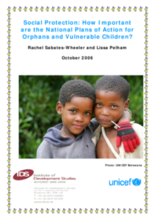A National Plan of Action (NPA) for Orphans and Vulnerable Children (OVC) is a government strategy document detailing a set of key objectives and the corresponding activities to address the national OVC situation. In general, NPAs share a common format, drawing their key objectives from the 2001 UN Declaration of Commitment on HIV/AIDS, generated at the UN General Assembly Special Session on HIV/AIDS. The plans are therefore oriented towards HIV/AIDS. NPAs are usually designed as a five year matrix, often broken down into one or two-year planning phases. The purpose is to respond comprehensively to OVC issues and to build upon areas which are insufficiently addressed by current OVC-related services.
NPAs therefore adopt a multi-sectoral approach. Although each NPA retains its individual characteristics, primarily they cover direct activities targeting OVC; institutional and legal arrangements to protect OVC; activities for the communication and publicity of OVC issues; and monitoring and evaluation of the progress of the NPA. Most of the NPAs have been costed. Financing of the NPAs is an ongoing process and is summarised in a recent review.
While many of the NPAs include a wide range of social protection activities, explicit reference to the term ‘social protection’ is only made in four of the NPAs (Malawi, Uganda, Tanzania and Rwanda). Except for the Tanzania NPA, which explicitly mentions social protection over 20 times, the others use the term only seven times in total. Simply looking at explicit use of the term ‘social protection’ does not provide a comprehensive review of how these documents engage with related issues. Therefore in order to get a more informed understanding of how the various NPAs actually incorporate social protection concerns it is necessary to look in-depth at the activities and programmes proposed within the plans. This is the main objective of this paper. The rest of this paper is structured around an evaluation of a variety of explicit and implicit assumptions related to vulnerability and social protection within the NPAs.
‘Social protection describes all public and private initiatives that provide income or consumption transfers to the poor, protect the vulnerable against livelihood risks, and enhance the social status and rights of the marginalised; with the objective of reducing the economic and social vulnerability of poor, vulnerable and marginalized groups.’ It is useful to elaborate briefly on the mechanisms that deliver social protection under the above definition as we will be reviewing the NPAs with these mechanisms in mind.
©Institute for Development Studies/UNICEF

